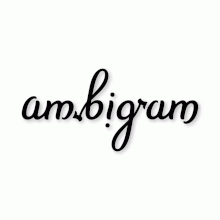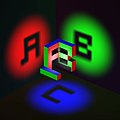Ambigram
An ambigram (from Latin ambo 'both' and Greek gramma 'writing') is commonly referred to as a lettering or a symmetrical symbol that, when rotated through a certain angle (usually 180 °), results in a lettering or a symbol. In the literal sense, it is therefore a question of writing that can be read from both given angles.
definition
The entire meaning of the term ambigram goes beyond the general designation, as Douglas Hofstadter defined in 1987 as follows:
“An ambigram is a visual pun of a special kind: a calligraphic design having two or more (clear) interpretations as written words. One can voluntarily jump back and forth between the rival readings usually by shifting one's physical point of view (moving the design in some way) but sometimes by simply altering one's perceptual bias towards a design (clicking an internal mental switch, so to speak). Sometimes the readings will say identical things, sometimes they will say different things. "
“An ambigram is a special kind of visual play on words: a calligraphic work has two or more (clear) readings. It is possible to switch between the different interpretations by changing the physical point of view (movement of the calligraphy), but sometimes a rethink is enough (so to speak, flicking an inner, mental switch). The readings are either identical or contain different statements. "
Ambigrams, in which a 'mental switch' has to be thrown to enable a different reading, is the calligraphic equivalent of the toggle figure .
Ambigram can also be defined as a typographical creation that allows two or more interpretations of a lettering.
A special form is the spinonym (derived from English (to) spin ' to rotate'), in which the individual characters are rotated.
Classification and structure
An ambigram can, but does not have to be, a palindrome at the same time . There are graphically adapted ambigrams or real font ambigrams. With a graphical change in the font, an ambigram can be formed from almost every word. But there are also ambigrams for which a graphical adjustment of the font is not necessary. Examples include words like opodo, pod, NOON, SONOS or SOS , XOX and WM . Often these fancy names make little or no sense, but are often used as brands or company names. In order to be able to use a real ambigram expression, you usually have to pay attention to uppercase and lowercase letters as well as suitable fonts. Suitable letters are: b, d, l, m, n, o, p, q, s, u, w, x, y, z, H, I, N, M, O, P, S, U, W, X, Y and Z.
But an ambigram can also be designed with numbers. The following are suitable here: 0, 1 (without upstroke and serif), 8, 6 and 9. Examples of rotatable numbers are 0, 1, 8, 11, 69, 88, 96, 101, 111, 181, 609, 619, 689 , 808, 818, 888, 906, 916, 986, 1001 etc. (see series A000787 in OEIS )
history
Peter Newell published the first known ambigram THE END / PUZZLE in 1893 .
The term "ambigram" was first used by Douglas Hofstadter , who ascribed it to one of his friends (book: Metamagical Themas, 1985).
Examples
Ambigrams have an increased advertising effect, as products can be read the same from different sides. That is why many logos are designed as ambigrams, such as the SONOS or SUN logo .
Ambigrams play a major role in the novel Angels & Demons by Dan Brown . The surname of the figure Emma Zunz in Jorge Luis Borges ' story of the same name is an ambigram.
Ambigram terminal , 180 ° rotational symmetry
Ambigram Geisha , 180 ° rotational symmetry.
A graphic in the style of the cover by Gödel, Escher, Bach : a three-dimensional ambigram of the letters A, B and C. In the middle form, each letter can be read individually, depending on the visual axis .
Ambigram Hillary Clinton / Donald Trump
See also
literature
- Scott Kim: Inversions: A Catalog of Calligraphic Cartwheels . Byte Books, 1981, ISBN 0-262-61041-8 .
- Douglas R. Hofstadter : Ambigrammi: Un microcosmo ideal per lo studio della creativita . Hopefulmonster Editore Firenze, 1987 (Italian).
-
Douglas R. Hofstadter : Metafont, Metamathematics, and Metaphysics: Comments on Donald Knuth 's Article "The Concept of a Meta-Font" . In: Metamagical Themes . S. 260-296 . Series of articles from Scientific American , published as a book under: Douglas R. Hofstadter: Metamagical Themes. Questing for the Essence of Mind and Pattern . Basic Books, 1996, ISBN 0-465-04566-9 . ; German as: Metamagicum. Questions about the essence of mind and structure. Klett-Cotta, Stuttgart 1988, ISBN 3-608-93089-2 .
- John Langdon: Wordplay: THE PHILOSOPHY, ART, AND SCIENCE OF AMBIGRAMS. Broadway Books New York 2005, ISBN 0-7679-2075-9
- Burkard Polster: Mathemagical Ambigrams . ( qedcat.com [PDF; 839 kB ]).
Web links
- Ambigrams by the artist Scott Kim (English)
- Ambigrams by the artist Pit Hammann
- Slambigrams - the Art of Ambigrams (German / English Ambigram blog)
- [[[Category: Wikipedia: Weblink offline]] ( Page no longer available , search in web archives: lovehate by Alessandro Iannuzz )] - lovehate ambigram logos
- Love / Hate project by Mia Florentine Weiss
- Blacksmith Records logo
Individual evidence
- ↑ What is an Ambigram? Ambigram definition. In: ambigram magazine. February 2010, archived from the original on February 17, 2010 ; accessed on May 26, 2013 (English).
- ^ The History of Ambigrams. In: ambigram magazine. April 18, 2009, archived from the original on December 3, 2009 ; accessed on May 26, 2013 (English).













